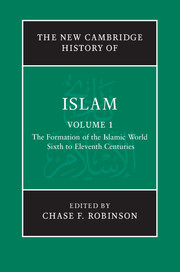Book contents
- Frontmatter
- Introduction
- PART I THE LATE ANTIQUE CONTEXT
- PART II UNIVERSALISM AND IMPERIALISM
- PART III REGIONALISM
- PART IV THE HISTORIOGRAPHY OF EARLY ISLAMIC HISTORY
- 15 Modern approaches to early Islamic history
- 16 Numismatics
- 17 Archaeology and material culture
- Conclusion: From formative Islam to classical Islam
- Glossary
- Bibliography
- Index
- Plate Section
- References
17 - Archaeology and material culture
from PART IV - THE HISTORIOGRAPHY OF EARLY ISLAMIC HISTORY
Published online by Cambridge University Press: 28 March 2011
- Frontmatter
- Introduction
- PART I THE LATE ANTIQUE CONTEXT
- PART II UNIVERSALISM AND IMPERIALISM
- PART III REGIONALISM
- PART IV THE HISTORIOGRAPHY OF EARLY ISLAMIC HISTORY
- 15 Modern approaches to early Islamic history
- 16 Numismatics
- 17 Archaeology and material culture
- Conclusion: From formative Islam to classical Islam
- Glossary
- Bibliography
- Index
- Plate Section
- References
Summary
The last four decades have witnessed a massive expansion in the archaeology of the Islamic past in regions stretching from the Iberian Peninsula to Indonesia. While the coverage of research is far from complete – for instance, the first/seventh- and second/eighth-century occupation phases in key cities such as Baṣra, Damascus and Baghdad remain largely unexplored, and excavations are not permitted in the Holy Cities of Mecca and Medina – archaeology is now able to provide important insights into the study of the early Islamic period. Aside from its obvious role in the discovery and recording of artefacts, the discipline’s most notable contribution to the study of early Islam is in the identification of economic, demographic and environmental processes that occur over the course of decades or centuries.
A recurrent concern in the archaeological study of early Islam is the degree to which the physical record exhibits significant continuity with the centuries prior to 1/622 (i.e. the Late Antique period). Conversely, the analysis of spatial and temporal patterns in the archaeological record from the first/seventh to the fourth/tenth centuries can reveal the emergence of new socio-cultural or economic phenomena. These competing dynamics are examined here with reference to four themes. The first part summarises the earliest evidence for a distinctive Muslim identity in the archaeological record.
Keywords
- Type
- Chapter
- Information
- The New Cambridge History of Islam , pp. 664 - 682Publisher: Cambridge University PressPrint publication year: 2010
References
- 3
- Cited by



